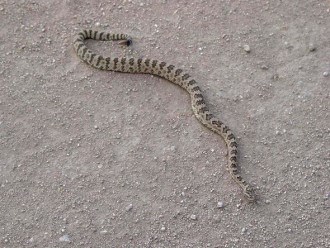
NPS Image - Pacific West Region Arizona is home to 11 species of rattlesnakes. Several of those species may be found in the Arizona Strip within the vicinity of Pipe Spring National Monument. Rattlesnakes documented in Mohave County, Arizona include the Sidewinder, Speckled Rattlesnake, Mohave Rattlesnake, Western Diamondback Rattlesnake, Great Basin Rattlesnake and Western Rattlesnake. However, the most common venomous snake found in Pipe Spring National Monument is the Great Basin Rattlesnake. Given a chance, a rattlesnake will avoid you. They typically use their rattles or tails as a warning when they feel threatened, but sometimes they may strike without warning. If cornered, they will defend themselves. Rattlesnakes can accurately strike at up to half their body length. Western Diamondbacks are among the most aggressive species of rattlesnakes and have a striking distance up to 66 percent of their body length. It has been estimated that 7,000-8,000 people per year receive venomous snake bites in the United States, and about five of those people die. Take the following steps to prevent a snake bite:
First Aid for Snake Bites: Venomous snake bites are medical emergencies and require immediate attention. The bite of a snake can cause severe local tissue damage and requires follow-up care. The following steps should be taken if someone has been bitten by a venomous snake.
Symptoms vary among victims and range in severity depending the snake's venom. Symptoms usually begin right away but may have a delayed onset. Symptoms may include the following:
Do NOT do any of the following if bitten by a snake:
|
Last updated: February 24, 2015
